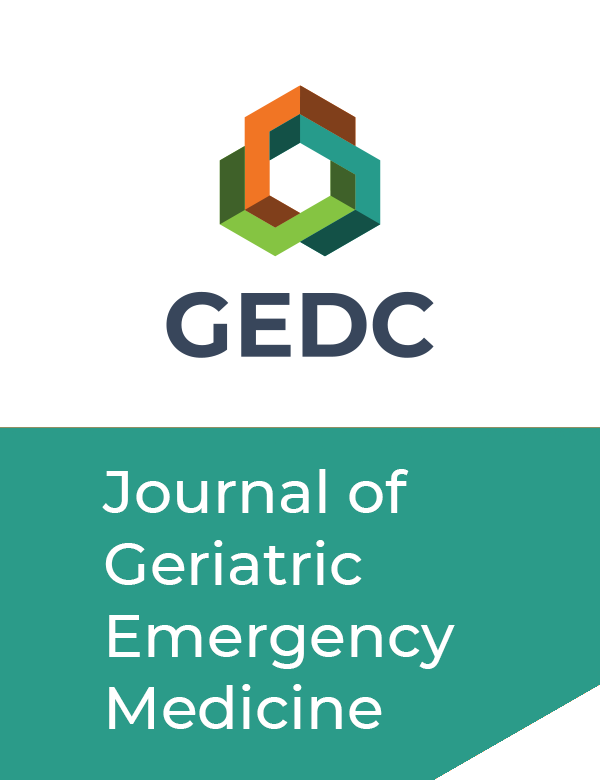Association of a Geriatric Emergency Department Innovation Program With Cost Outcomes Among Medicare Beneficiaries
Volume 2 | Issue 5 | Sentinel Paper
Full TextThe Journal of Geriatric Emergency Medicine (JGEM) is happy to feature important articles affecting the emergency care of older adults. We would like to highlight the JAMA Network Open Original Investigation by Dr. Ula Hwang and colleagues on “Association of a Geriatric Emergency Department Innovation Program with Cost Outcomes among Medicare Beneficiaries.” The article concluded that “Among Medicare Fee for service beneficiaries, receipt of ED-based geriatric treatment by a Transitions Care Nurse and or a Social Worker was associated with lower Medicare expenditures. These estimated cost savings may be used when calculating or considering the bundled value and potential reimbursement per patient for Geriatric Emergency Department care programs.”
The following is a commentary by the lead author and by a topic expert.
In the “Association of a Geriatric Emergency Department Innovation Program With Cost Outcomes Among Medicare Beneficiaries” JAMA Network Open paper from March 1, 2021, investigators were able to compare total costs of care for Medicare beneficiaries who were seen by trained geriatrics ED care personnel – either a transitional care nurse, a social worker, or both, versus similar patients not seen by anyone in the ED with geriatrics care.1 They found an average a savings of $2,000 to $3,000 per patient in the immediate 1 to 2 month period following their ED visit for the patients who were seen by the Geriatric Emergency Department (GED) staff. While this study focused on Medicare patients, and demonstrated savings to Medicare for when older ED patients receive geriatrics specific emergency care activities, more importantly it quantifies the dollar impact in savings GED care can have with avoidable hospitalizations, or reduced hospital readmissions.
Dr. Hwang’s study shows substantial cost savings for patients that experience one of the core interventions of highly functioning geriatric emergency departments (GEDs): seeing a care transition nurse (TCN) or social worker (SW) in the ED focused on the needs of older adults. Patients who saw a TCN or SW had mean health care savings of over $2000 per patient, likely due to decreased hospital admissions. This validates one of the central premises of the GED movement: that addressing underlying geriatric syndromes and social support needs in the ED can decrease cost by avoiding medically unhelpful admissions. Showing substantial costs savings should make it easier to garner support from those who pay for health care, such as Medicare and Medicare Advantage (MA) plans.
These demonstrated savings, however, do not necessarily equal improved bottom lines for the health care systems that are providing (and paying for) this enhanced geriatric emergency care. In fact, if the hospitals make money from admitting older adults who don’t need surgery or interventions, the hospitals who support GEDs might actually lose money. (Admittedly, most hospitals do not make much money if any from admitting frail older adults who do not need significant procedural interventions, and this is especially true if the hospital is full.). So, for those of us who are advocating for improved geriatric emergency care in our home hospitals, rather than going to the CEO of the hospital, showing them Dr Hwang’s study, and saying “look how much money a GED will make us”, you should inquire as to what risk-based contracts and/ or Accountable Care Organizations (ACOs) your hospital is engaged with. In risk-based contracting (such as your hospital may have with local MA plans), or ACOs, these costs savings that Dr. Hwang’s paper demonstrates will indeed translate into an improved bottom line. This study is a significant step forward in demonstrating the positive impact of GEDs in creating a more sustainable system of acute unscheduled care for older adults, but we will want to use its findings strategically to advance our drive to gather resources to improve emergency care for older adults.
Full JAMA Network Open ArticleKEY WORDS
Costs of care, transitions care nurse, Medicare shared risk contracts
Author Affiliations
Kevin Biese, MD
- Department of Emergency Medicine, Department of Emergency Medicine, University of North Carolina School of Medicine, Chapel Hill, NC
Ula Hwang, MD, MPH
- Department of Emergency Medicine, Icahn School of Medicine at Mount Sinai, New York, NY
- Department of Geriatrics and Palliative Medicine, Icahn School of Medicine at Mount Sinai, New York, NY
- Geriatrics Research, Education and Clinical Center, James J. Peters VAMC, Bronx, NY
Conflict of Interest
The authors have no conflicts to report.
References
- Hwang U, Dresden SM, Vargas-Torres C, et al. Association of a Geriatric Emergency Department Innovation Program With Cost Outcomes Among Medicare Beneficiaries. JAMA Netw Open. 2021;4(3):e2037334. doi:10.1001/jamanetworkopen.2020.37334
